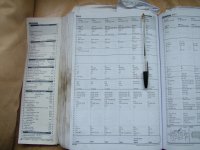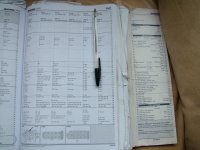You are using an out of date browser. It may not display this or other websites correctly.
You should upgrade or use an alternative browser.
You should upgrade or use an alternative browser.
Technical 2000 Fiat Ducato 1.9TD
- Thread starter Kevinlock
- Start date
Currently reading:
Technical 2000 Fiat Ducato 1.9TD
Would need the engine series number, possible starting DHX or XUD, may be on the chassis weight plate on bonnet slam panel .
My Autodata Timing Belt Book 2012 only goes back to 2002 with the bigger engines of Ducato, but the 1.9 turbo was used in several French vehicles also hence the engine series number needed.
It's possible if belt broke that valve damage on those engines can happen, so may be necessary to start by removing camshaft cover to see if any obvious damage or if some valve to cam lobe clearances are very excessive caused by damage.
I have the Auto Data Technical Manual 2012 also which depending on engine series etc. does list your size Ducato engine with torque settings and lots of other information.
Other Forum members will have belt details I am sure.
My Autodata Timing Belt Book 2012 only goes back to 2002 with the bigger engines of Ducato, but the 1.9 turbo was used in several French vehicles also hence the engine series number needed.
It's possible if belt broke that valve damage on those engines can happen, so may be necessary to start by removing camshaft cover to see if any obvious damage or if some valve to cam lobe clearances are very excessive caused by damage.
I have the Auto Data Technical Manual 2012 also which depending on engine series etc. does list your size Ducato engine with torque settings and lots of other information.
Other Forum members will have belt details I am sure.
Thanks for the quick response, the engine series number is DHX 230BNMAB OEWould need the engine series number, possible starting DHX or XUD, may be on the chassis weight plate on bonnet slam panel .
My Autodata Timing Belt Book 2012 only goes back to 2002 with the bigger engines of Ducato, but the 1.9 turbo was used in several French vehicles also hence the engine series number needed.
It's possible if belt broke that valve damage on those engines can happen, so may be necessary to start by removing camshaft cover to see if any obvious damage or if some valve to cam lobe clearances are very excessive caused by damage.
I have the Auto Data Technical Manual 2012 also which depending on engine series etc. does list your size Ducato engine with torque settings and lots of other information.
Other Forum members will have belt details I am sure.
Sorry my timing belt book only goes back to the one just after yours. Your vehicle was probably one of the last DHX versions in 1999 but registered 2000 My Auto Data Technical Service Manual may be of general use for torque settings oils etc. I also found this on the internet about what vehicles used your engine seies numberDHX. Apart from that I am sure other Forum members can help further.
Search Engine code DHX stock
Engine code DHX
Submit Engine code DHX requestSearch Engine code DHX stock
| Make | Year of construction Engine capacity |
|---|---|
| Citroen Jumpy | 1999 1,905 cc 2000 1,900 cc 2002 1,905 cc |
| Citroen Evasion | 2000 1,905 cc |
| Citroen Jumper | 1995 1,905 cc 2000 1,900 cc, 1,905 cc 2001 1,900 cc, 1,905 cc |
| Citroen Xantia | 1997 1,900 cc 1998 1,900 cc, 1,905 cc 1999 1,905 cc 2001 1,905 cc |
| Peugeot 406 | 1995 1,900 cc 1996 1,900 cc 1997 1,900 cc, 1,905 cc 1998 1,900 cc, 1,905 cc 1999 1,905 cc |
| Peugeot 806 | 1998 1,900 cc 1999 1,900 cc 2000 1,905 cc |
| Fiat Ducato | 1997 1,900 cc 1998 1,900 cc 1999 1,905 cc 2000 1,900 cc 2002 - |
| Peugeot Expert | 1998 1,905 cc 1999 1,905 cc |
| Fiat Scudo | 1999 1,905 cc 2000 1,900 cc, 1,905 cc |
| Fiat Ulysse | 2000 1,905 cc |
Attachments
Much appreciatedSorry my timing belt book only goes back to the one just after yours. Your vehicle was probably one of the last DHX versions in 1999 but registered 2000 My Auto Data Technical Service Manual may be of general use for torque settings oils etc. I also found this on the internet about what vehicles used your engine seies numberDHX. Apart from that I am sure other Forum members can help further.
Engine code DHX
Submit Engine code DHX request
Search Engine code DHX stock
Make Year of construction
Engine capacityCitroen Jumpy 1999
1,905 cc
2000
1,900 cc
2002
1,905 ccCitroen Evasion 2000
1,905 ccCitroen Jumper 1995
1,905 cc
2000
1,900 cc, 1,905 cc
2001
1,900 cc, 1,905 ccCitroen Xantia 1997
1,900 cc
1998
1,900 cc, 1,905 cc
1999
1,905 cc
2001
1,905 ccPeugeot 406 1995
1,900 cc
1996
1,900 cc
1997
1,900 cc, 1,905 cc
1998
1,900 cc, 1,905 cc
1999
1,905 ccPeugeot 806 1998
1,900 cc
1999
1,900 cc
2000
1,905 ccFiat Ducato 1997
1,900 cc
1998
1,900 cc
1999
1,905 cc
2000
1,900 cc
2002
-Peugeot Expert 1998
1,905 cc
1999
1,905 ccFiat Scudo 1999
1,905 cc
2000
1,900 cc, 1,905 ccFiat Ulysse 2000
1,905 cc
so looking at that am i right in saying if the timing marker is set then the intake value on piston 1 should be closed about to open
I can't say for sure on that engine, the nearest to me was the XUD engine which was also 1905cc and when doing those in Peugeot 305s etc. I had a special tool that fitted into the flywheel from behind the starter for TDC I think, then the cam and diesel pump marks should be inlined to their marks, unless 180 degrees out so another turn of the crankshaft.
Hopefully someone on Forum has correct timing details for your model.
First though I would be inclined if belt has broken to remove cam cover to check for possible signs of valve damage etc. in case the plot thickens, so you know what possible other expenses.
Obviously if you have to take the cylinder head off for broken valves then it will be easier to check if the tool in flywheel corresponds with TDC on your vehicle and if with valves on the rock on no 4 cyl it should be firing on no 1 so injector pump sprocket can be set to marks as a basic way of doing things, but always much safer to have the correct technical data.
Whatever happens always after assembly turn engine by hand several times and stop at timing marks to ensure nothing is fouling, so when you turn the key hopefully no damage occurs.
Hopefully someone on Forum has correct timing details for your model.
First though I would be inclined if belt has broken to remove cam cover to check for possible signs of valve damage etc. in case the plot thickens, so you know what possible other expenses.
Obviously if you have to take the cylinder head off for broken valves then it will be easier to check if the tool in flywheel corresponds with TDC on your vehicle and if with valves on the rock on no 4 cyl it should be firing on no 1 so injector pump sprocket can be set to marks as a basic way of doing things, but always much safer to have the correct technical data.
Whatever happens always after assembly turn engine by hand several times and stop at timing marks to ensure nothing is fouling, so when you turn the key hopefully no damage occurs.
many thanks will take your adviceI can't say for sure on that engine, the nearest to me was the XUD engine which was also 1905cc and when doing those in Peugeot 305s etc. I had a special tool that fitted into the flywheel from behind the starter for TDC I think, then the cam and diesel pump marks should be inlined to their marks, unless 180 degrees out so another turn of the crankshaft.
Hopefully someone on Forum has correct timing details for your model.
First though I would be inclined if belt has broken to remove cam cover to check for possible signs of valve damage etc. in case the plot thickens, so you know what possible other expenses.
Obviously if you have to take the cylinder head off for broken valves then it will be easier to check if the tool in flywheel corresponds with TDC on your vehicle and if with valves on the rock on no 4 cyl it should be firing on no 1 so injector pump sprocket can be set to marks as a basic way of doing things, but always much safer to have the correct technical data.
Whatever happens always after assembly turn engine by hand several times and stop at timing marks to ensure nothing is fouling, so when you turn the key hopefully no damage occurs.
I suspect this is all documented on here from a decade ago..
SEARCH can be pretty good
SEARCH can be pretty good
Hi,
Cylinder head will have to come off to be refurbished, damaged valves replaced, valve guides checked and replaced if split.
Pistons should be removed to check pistons rings not trapped in grooves by impact with valves.
Unfortunately a new timing belt on its own would be a waste of time.
Best of luck
Jack
Cylinder head will have to come off to be refurbished, damaged valves replaced, valve guides checked and replaced if split.
Pistons should be removed to check pistons rings not trapped in grooves by impact with valves.
Unfortunately a new timing belt on its own would be a waste of time.
Best of luck
Jack
I'm concerned for you .......so.....
The video shows a Lucas injection pump you may have a Bosch pump, come back on here if your injection pump is Bosch and has different locking holes.
I would be totally stunned if you get away with just a new belt , please let us know how you get on
The video shows a Lucas injection pump you may have a Bosch pump, come back on here if your injection pump is Bosch and has different locking holes.
I would be totally stunned if you get away with just a new belt , please let us know how you get on
I did wonder if the DHX timing was similar to the XUD engines which I had done in the past both being 1905cc versions. Somewhere in my garage is the Z shape flywheel timing tool that is made so you went behind the starter without removing it. So all the other timing locking can be done with drill bits.
Please be aware references to TDC can be very misleading when it comes to belt changing and injection pump timing pre-common rail . Lots of manufacturer manuals and other manuals refer to setting TDC and they don't actually mean TDC at all. They mean the set point for the belt change which can be 90 degrees before TDC (typically French but not always)
Ford PUMA type engines 50 degrees before TDC
Fiat mix it up with sometimes TDC is TDC and other times it is 90 degrees before TDC.
Ford PUMA type engines 50 degrees before TDC
Fiat mix it up with sometimes TDC is TDC and other times it is 90 degrees before TDC.
Similar threads
- Replies
- 1
- Views
- 137



